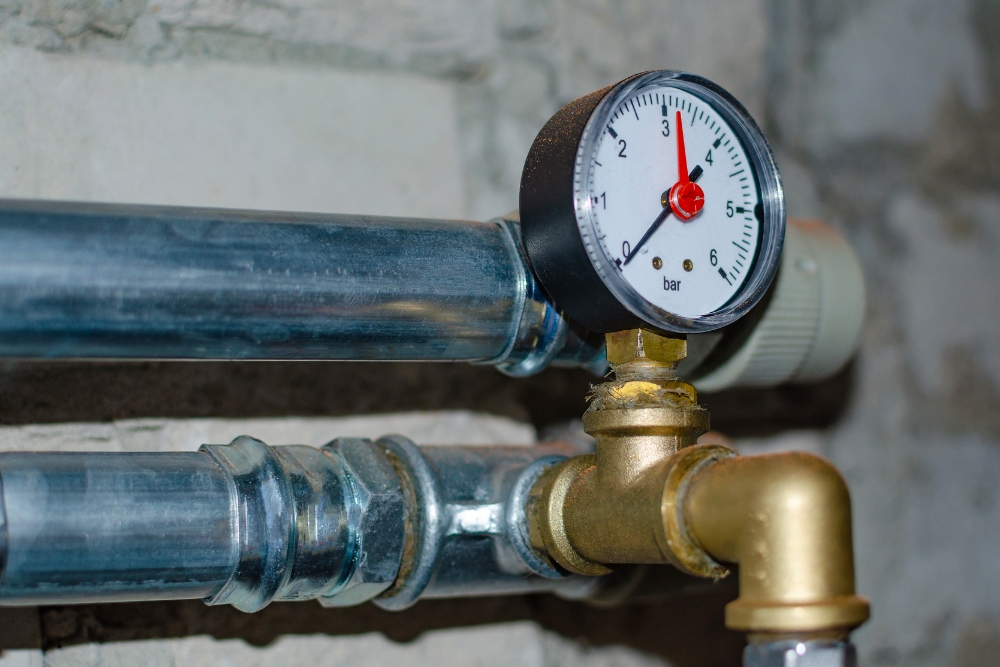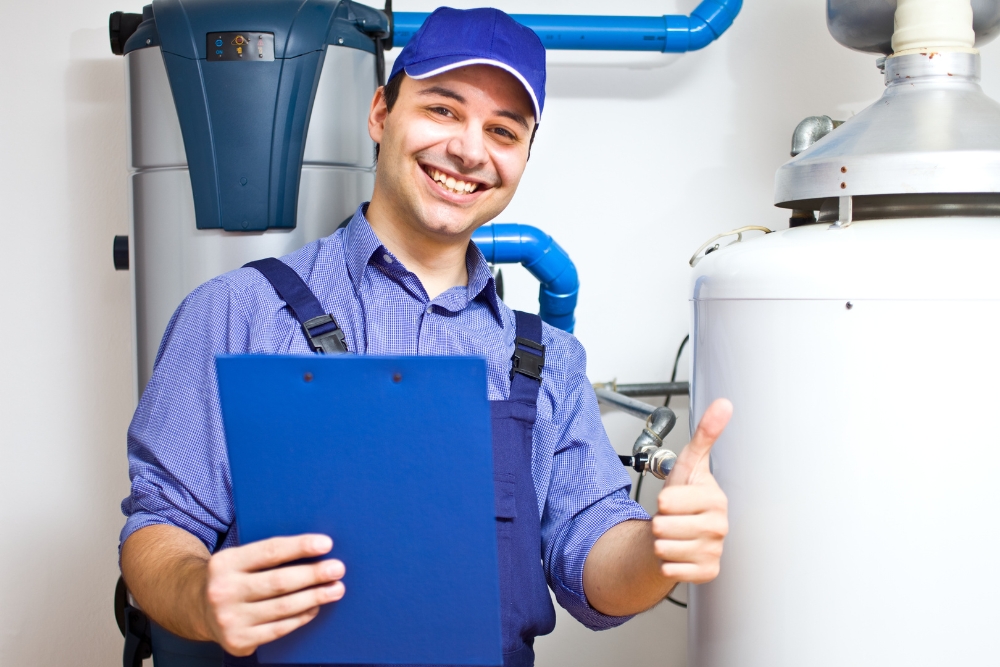Ever been jolted awake by a chilly splash when you were hoping for a warm wake-up call, or nearly jumped out of your skin thanks to an unexpected burst of boiling water? Yeah, we get how maddening that can be – it’s usually a dead giveaway that your thermostat’s throwing a bit of a tantrum.
In our thorough look into sorting out hot water system hiccups, we’ll shed light on just how crucial having a reliable thermostat is and the comfort of knowing yours is in tip-top shape.
Key Takeaways
- Thermostats are vital for maintaining the desired water temperature in hot water system repairs, acting as switches that turn on and off to heat the water.
- Signs of a faulty thermostat include inconsistent water temperatures, such as very cold or overly hot showers, and sometimes even a leaking tank.
- Regular maintenance of your hot water thermostat is key to improving system efficiency, performance, and lifespan.
- For replacing a faulty thermostat, it’s safer and more reliable to hire a professional due to the technical knowledge required for proper installation.
- Commonly needed repairs for hot water systems can range from grounding corrections and pressure relief valve replacement to flushing sediment buildup.
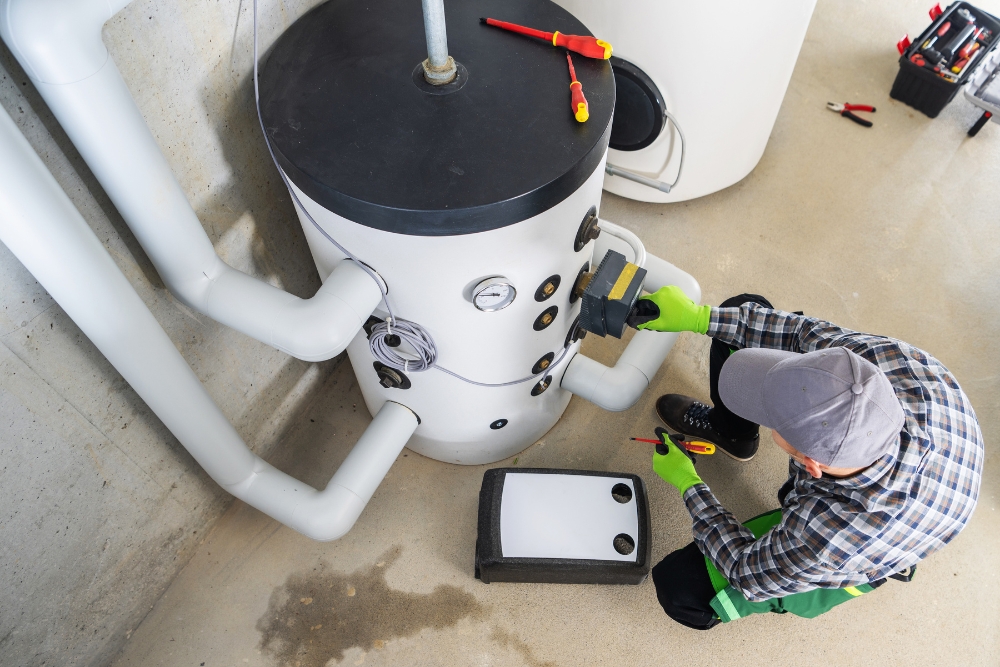
Understanding the Role of Thermostats in Hot Water Systems
The thermostat in a hot water system plays a crucial role in controlling the water temperature. It works with different components of the system to ensure that you have consistent and comfortable hot water whenever you need it.
How thermostats control water temperature
Thermostats in our hot water systems act like vigilant guardians, making sure the water temperature stays right where we want it. Picture a thermostat as a switch that flips on to heat the water when it’s too cold and turns off when the perfect temperature is reached.
They monitor the water’s warmth constantly, ensuring each shower or bath is comfortably consistent.
We often find separate thermostats attached to different heating elements within our electric heaters, giving us precise control over temperature regulation. This smart feature helps maintain energy efficiency by only using power when necessary to reach desired temperatures.
If your morning shower starts turning into an icy wake-up call or an unexpected sauna session, it might be time for us to check out those thermostats and ensure they’re doing their job properly!
Different components of a hot water system
The hot water system consists of several key components that work together to provide a steady supply of heated water. These components include:
- Water Heater Tank: This is where the water is stored and heated, either by gas or electricity, and typically includes an insulated tank to maintain the water temperature.
- Heating Elements: Electric water heaters have two heating elements, while gas heaters have a burner. These elements are responsible for heating the water inside the tank.
- Thermostats: The system contains one or more thermostats that regulate the temperature of the water by controlling the operation of the heating elements.
- Pressure Relief Valve: It is crucial for maintaining safe pressure levels within the system by releasing excess pressure to prevent damage to the tank or pipes.
- Dip Tube: This component directs cold water to the bottom of the tank, ensuring consistent distribution and optimal heating efficiency.
- Drain Valve: Used for draining and flushing out sediment buildup from the bottom of the tank, helping to maintain water quality and system performance.
- Anode Rod: Designed to prevent corrosion within the tank by attracting corrosive particles, thereby prolonging the life of the system.
Signs of a Faulty Hot Water Thermostat
When your hot water system thermostat is faulty, you may notice erratic water temperatures, from freezing cold to scalding hot. An inconsistent water temperature can be a sign that your thermostat needs attention.
Chilly or scorching hot water
If the water from your hot water system feels chilly or scorching hot, it could be a sign of a faulty thermostat. Inconsistent water temperature is one of the symptoms of a bad thermostat, indicating that it may not be effectively controlling the heating elements.
This issue can disrupt your daily activities and utility usage, impacting energy efficiency and overall comfort in your home.
A malfunctioning thermostat can lead to discomfort due to irregular water temperature levels. It’s important to address this problem promptly by seeking professional assistance to diagnose and repair any issues with the thermostat.
Inconsistent water temperature
Sometimes, you may notice that your hot water temperature fluctuates, making it difficult to enjoy a consistent and comfortable shower or bath. This inconsistency in water temperature could be a sign of a faulty thermostat in your hot water system.
If the thermostat is not signalling for the heating element to kick in when needed, it can lead to variations in the water’s temperature. It’s essential to address this issue promptly as inconsistent water temperature can disrupt your daily routine and indicate an underlying problem with the thermostat.
A malfunctioning thermostat might fail to regulate the heating elements properly, resulting in unpredictable shifts between hot and cold water. In such cases, it’s crucial to have a professional assess and potentially replace the faulty thermostat to ensure a reliable and steady hot water supply throughout your home.
Leaking tank
A leaking tank in your hot water system could indicate a faulty thermostat or pressure relief valve. This issue can cause water damage and reduce the efficiency of your system. It’s essential to address any leaks promptly to prevent further damage and potential safety hazards, as well as to avoid excessive energy consumption due to heat loss from the hot water tank.
When dealing with a leaking tank, it’s crucial to turn off the power supply to the hot water system and contact a professional plumber or electrician immediately for repairs. Ignoring a leaking tank can lead to more significant problems down the line, including the need for costly repairs or even heater replacement.
Proper maintenance and timely repairs are key to keeping your hot water system functioning efficiently.
Importance of Regular Maintenance for Hot Water Thermostats
Regular maintenance for hot water thermostats is crucial in improving the efficiency and performance of your system. It also helps in extending the lifespan of your hot water system, which can save you money on costly repairs or replacements in the long run.
Improving efficiency and performance
To enhance efficiency and performance, regular maintenance of the hot water system and thermostat is essential. This includes checking for any signs of wear or malfunction, adjusting the settings to optimise energy usage, and ensuring that all components are functioning properly.
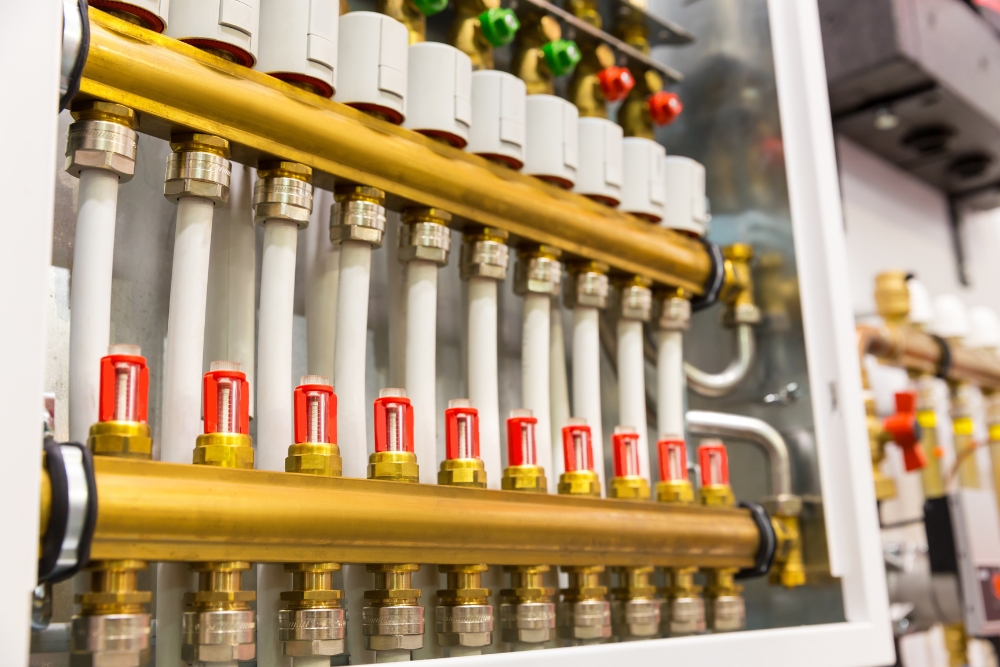
By maintaining the thermostat and the entire system, you can improve energy efficiency and prolong its lifespan. It also helps in preventing unexpected breakdowns and costly repairs which can disrupt your daily routine.
Additionally, scheduling periodic inspections with a professional technician will ensure that any potential issues are addressed promptly.
Extending the lifespan of the system
Improving efficiency and performance through regular maintenance is crucial for prolonging the lifespan of your hot water system. By ensuring that the thermostats are functioning optimally, you can prevent excessive wear and tear on the system’s components.
Regular maintenance not only extends the lifespan of your hot water system but also helps in reducing energy consumption, saving you money in the long run.
Maintaining your hot water thermostat helps to identify any potential issues early on, preventing them from escalating into major problems that could compromise the entire system. This proactive approach ensures that your hot water system continues to operate efficiently and reliably over an extended period, providing consistent access to hot water whenever needed without unexpected breakdowns.
Tips for Replacing a Faulty Thermostat
When it comes to replacing a faulty thermostat in your hot water system, it’s important to follow the steps carefully and make sure to hire a professional for the job. This will ensure that the replacement is done correctly and safely, allowing your hot water system to function effectively once again.
Steps to replace a hot water thermostat
To replace a hot water thermostat, first, turn off the power to the water heater at the circuit breaker. Then, locate the thermostat panel on the water heater. Unscrew and remove the panel cover to access the thermostat. Next, use a voltage tester to ensure there is no electricity flowing to the thermostat. Disconnect the wires from the old thermostat using a screwdriver. Remove the old thermostat and insert the new one in its place, reconnecting the wires following manufacturer instructions. Finally, replace the panel cover, turn on the power at the circuit breaker, and adjust your water temperature setting as needed.
The importance of hiring a professional
Hiring a professional for hot water system repairs is crucial due to the complex nature of the job. Professional technicians possess the necessary expertise to navigate both plumbing and electrical components in a safe and efficient manner.
They can accurately diagnose thermostat issues, utilise the correct tools, and ensure that replacements are properly installed. Furthermore, hiring a professional ensures that any warranty requirements are met, preventing the voiding of warranties and ensuring long-term peace of mind for homeowners.
Moreover, professionals have the knowledge to troubleshoot potential underlying problems within the overall system while replacing faulty thermostats. This comprehensive approach addresses not only immediate issues but also helps prevent future malfunctions or breakdowns.
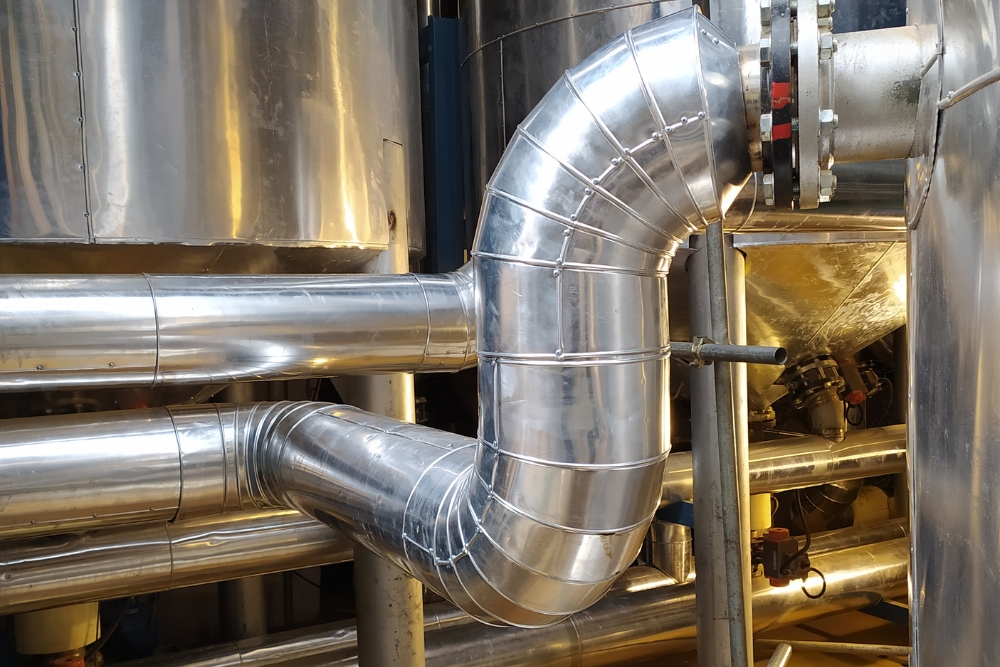
Sources for Replacement Thermostats
When the time comes to replace a faulty thermostat in your hot water system, you can find replacement thermostats at hardware stores and home improvement centres. Many online retailers also offer a variety of options for different types and brands of hot water systems.
It’s essential to ensure that the replacement thermostat is compatible with your specific model of water heater before making a purchase. You might want to consult the manufacturer’s recommendations or seek advice from a professional if you’re unsure about which thermostat to choose.
Considering the crucial role that thermostats play in maintaining an efficient and reliable hot water system, it’s important not to compromise on quality when selecting a replacement part.
Additionally, be mindful of any warranty implications associated with third-party parts or installation by non-certified professionals.
Common Repairs for Hot Water Systems: Grounding, Pressure Relief, and More
Hot water systems commonly require repairs to ensure optimal functioning and efficiency. Here are some common repairs that may be needed:
- Earthing: Ensuring proper earthing for the hot water system is crucial for safety and efficient operation. Faulty earthing can lead to electrical hazards and affect the performance of the system.
- Pressure Relief Valve Replacement: The pressure relief valve plays a vital role in maintaining safe pressure levels within the hot water system. Replacing a faulty pressure relief valve is essential to prevent potential damage or dangers caused by excessive pressure.
- Heating Element Maintenance: Regular inspection and maintenance of heating elements are essential for ensuring a consistent hot water supply. As part of routine maintenance, any damaged or worn-out heating elements should be replaced promptly to maintain optimal performance.
- Anode Rod Replacement: The anode rod helps protect the hot water system from corrosion by sacrificing itself to protect the tank. Regular inspection and replacement of a worn or corroded anode rod can extend the lifespan of the system.
- Thermostat Calibration: Proper calibration of thermostats is crucial for accurate temperature control within the hot water system. Calibration ensures energy efficiency and prevents issues such as scalding or lukewarm water.
- Leak Repairs: Addressing any leaks in pipes, valves, or fittings is essential to prevent water wastage and potential damage to the surrounding areas. Prompt leak repairs can help maintain the integrity of the hot water system.
- Flushing Sediment Buildup: Over time, sediment buildup in the tank can affect the efficiency of the hot water system and lead to potential damage. Regular flushing to remove sediment buildup is necessary for optimal performance.
- Electrical Connection Checks: Periodic inspection of electrical connections within the hot water system is important for identifying any loose or damaged connections that may affect its operation.
Your Space, Our Priority – Fast Hot Water Restoration!
In summary, understanding the crucial role of thermostats in hot water systems is essential for maintaining consistent and comfortable water temperatures. Regular maintenance can improve efficiency and extend the lifespan of your system.
If you notice any signs of a faulty thermostat, it’s important to take steps to address the issue promptly. Replacing a faulty thermostat may require professional help due to the complexity of hot water system repairs.
Is your hot water system acting up? The thermostat might be the culprit. At Hot Water Repairs Today, we understand the crucial role that thermostats play in maintaining optimal water temperature. Our skilled technicians specialize in diagnosing and repairing thermostat issues to ensure your hot water system functions efficiently. Don’t let temperature inconsistencies disrupt your comfort. Trust Hot Water Repairs Today for reliable thermostat repairs. Schedule your service now, and let us restore your hot water system to its full potential. Contact Us Now!

